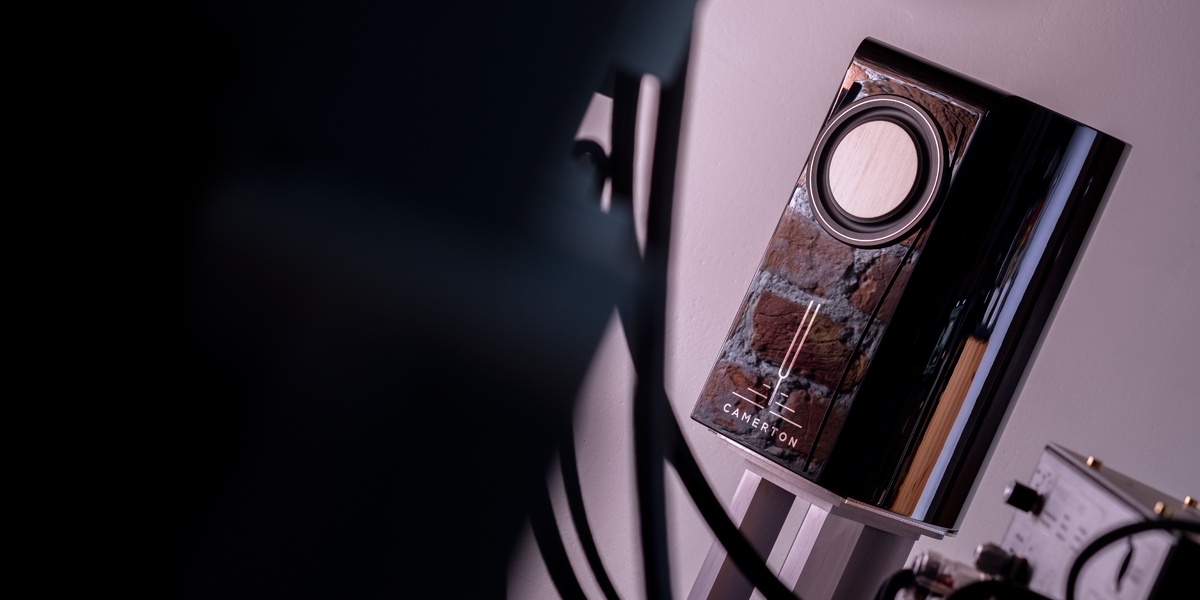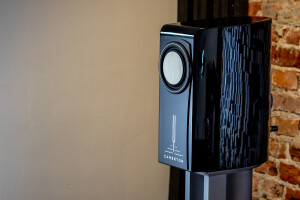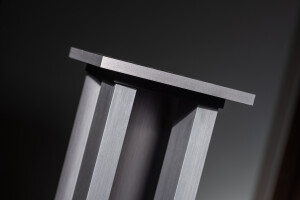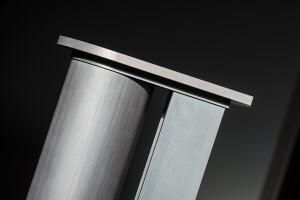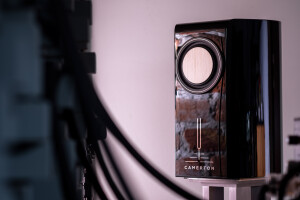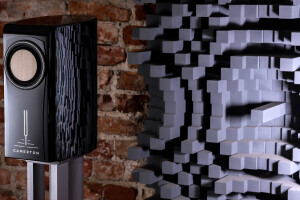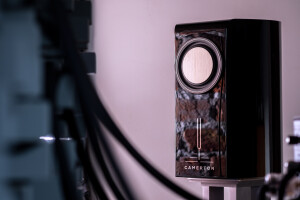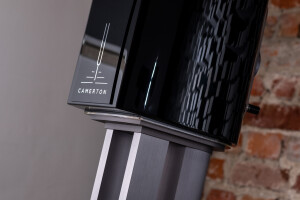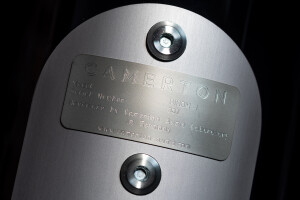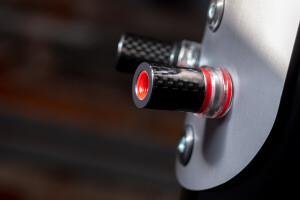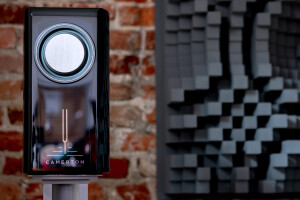It’s no secret knowledge that small full-range drivers demand either stout enclosures or extra transducers to get going. This report’s Camerton Binom-1 however was designed to get by perfectly fine without these necessary measures, and now it’s time to find out whether it can truly do that. Enjoy!
Introduction
I’d like to think that the more years I have under my reviewer belt, the more comprehensively I’m able to cover each new arrival and grasp its maker’s intent. But instead I reflect mainly on how tiny my exposure to such hardware really is, and how much I still don’t and quite possibly won’t ever know about this hobby. Over the years it proved me multiple times how surprising it can be, and how passé many its topological stereotypes are. Class D amps can be voiced like lightning-fast class AB and rich class A types. Petite vented speakers can mimic large dipole action. DACs with romantic 300B glass at their output stages can be pinpoint accurate and quick, and those with modern fully exposed resistor ladders respectively milder, darker and calmer. Tubed line stages can hit very hard. Inconspicuous titanium decouplers and signal conditioners can be disturbingly effective. Routers and network switches can be audibly happier with linear power feed, even though it should make no difference to externals outside the signal path. This list serves me as a handy reminder to expect the unexpected, take nothing for granted and keep my mind open. Today’s speaker set stretched it even further. In fact, upon hearing about this unique design say two years ago I honestly wouldn’t believe it actually exists.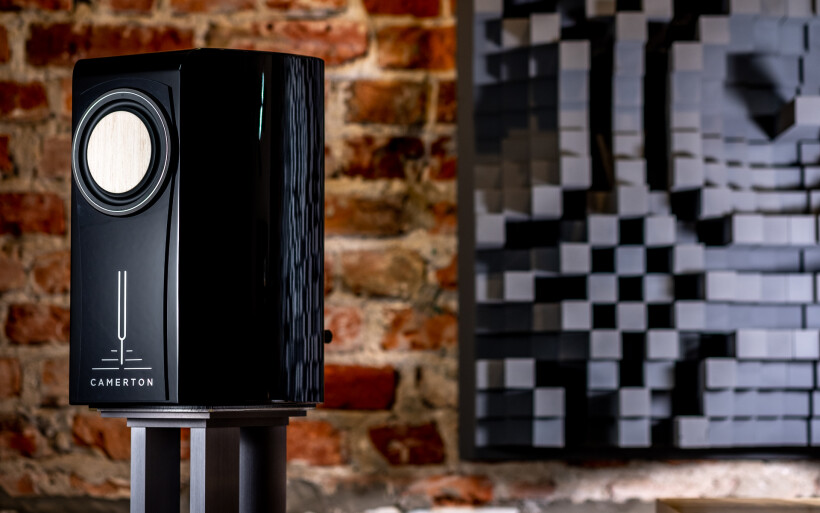 Although full-range speakers are considered as inherently finicky demanding niche stuff for enthusiasts with peculiar taste, that’s not my experience. Subjectively speaking they make wonderful sound, only one was rather challenging on hardware compliance and I’ve sampled quite a few in recent years. Voxativ’s and Cube Audio’s loaners were purist designs based on in-house developed drivers inside stout cabinets without crossovers, and so was RDacoustic’s product that incorporated even larger boxes and outsourced off-the-shelf widebanders. PureAudioProject’s large open baffles had Voxativ’s drivers mounted just above proper woofers. Rethm’s speaker set featured this company’s own full-range units reinforced with active isobaric subs fueled by internal class D amps. sound|kaos’ tiny passive 3-ways sported kosher Enviée drivers tailored specifically for them, and assisted by ribbons plus twin side-firing bass. It’s fair to say that this lot stretches far and wide, but it misses a compact enclosure with just one full-range speaker that would effortlessly cover the entire audible bandwidth. That’s the tricky part, those are mutually exclusive things after all, or so I thought. Until recently I simply had no evidence to think that unsupported widebanders inside small boxes can do everything on their own, but now I do.
Although full-range speakers are considered as inherently finicky demanding niche stuff for enthusiasts with peculiar taste, that’s not my experience. Subjectively speaking they make wonderful sound, only one was rather challenging on hardware compliance and I’ve sampled quite a few in recent years. Voxativ’s and Cube Audio’s loaners were purist designs based on in-house developed drivers inside stout cabinets without crossovers, and so was RDacoustic’s product that incorporated even larger boxes and outsourced off-the-shelf widebanders. PureAudioProject’s large open baffles had Voxativ’s drivers mounted just above proper woofers. Rethm’s speaker set featured this company’s own full-range units reinforced with active isobaric subs fueled by internal class D amps. sound|kaos’ tiny passive 3-ways sported kosher Enviée drivers tailored specifically for them, and assisted by ribbons plus twin side-firing bass. It’s fair to say that this lot stretches far and wide, but it misses a compact enclosure with just one full-range speaker that would effortlessly cover the entire audible bandwidth. That’s the tricky part, those are mutually exclusive things after all, or so I thought. Until recently I simply had no evidence to think that unsupported widebanders inside small boxes can do everything on their own, but now I do. So there I was, perfectly happy minding my own business and then this Srajan’s story had happened. We learn from it about the Ukrainian engineer Oleh Lizohoub, who created his first full-range driver in 1995 as a schoolboy. Interestingly this wasn’t a mod of any specific unit, but a project made from scratch with classic balsa cones calculated accordingly to the method used for airplane wing profiles. Oleh founded the Camerton company in 1999 in Ukraine, where it was operational until September 2011, but the idea of pursuing flat membrane transducers simmered on his backburner for nearly a decade. He got back to these designs in 2008 and moved to Berlin three years later. Camerton was officially relaunched there in 2019, and its introductory speaker set baptized Camerton Binom-1 was showcased for the first time in public during Munich’s alternate event at the Marriott Hotel. Srajan’s first experience with this unusual full-range monitor product he described as borderline absurd, which naturally got me very curious. Past a brief mail exchange with its maker a loaner pair with matched stands was dispatched my way, and that’s how today’s story came to be.
So there I was, perfectly happy minding my own business and then this Srajan’s story had happened. We learn from it about the Ukrainian engineer Oleh Lizohoub, who created his first full-range driver in 1995 as a schoolboy. Interestingly this wasn’t a mod of any specific unit, but a project made from scratch with classic balsa cones calculated accordingly to the method used for airplane wing profiles. Oleh founded the Camerton company in 1999 in Ukraine, where it was operational until September 2011, but the idea of pursuing flat membrane transducers simmered on his backburner for nearly a decade. He got back to these designs in 2008 and moved to Berlin three years later. Camerton was officially relaunched there in 2019, and its introductory speaker set baptized Camerton Binom-1 was showcased for the first time in public during Munich’s alternate event at the Marriott Hotel. Srajan’s first experience with this unusual full-range monitor product he described as borderline absurd, which naturally got me very curious. Past a brief mail exchange with its maker a loaner pair with matched stands was dispatched my way, and that’s how today’s story came to be.
Build
Camerton’s two speakers shared one double cardboard and each stand arrived inside its own. All boxes featured internal reinforcing panels made of chipboard. Two thick styro liners locked into place both monitors wrapped in stretch foil and each inside its own cloth bag. Stands with their top and bottom bases bolted to larger MDF boards were positioned right in the middle of their cartons, so had lots of space around their legs to cleverly reduce the risk of damage during transportation. A manual and all necessary tools to unbolt them were provided. All in all, Oleh’s packaging was nicely thought-out and I had no reasons to complain. Let’s talk stands first. They’re unapologetically expensive (€4’400/pr), but past unpeeling them from their boxes I instantly understood why. Although perfectly functional, my stationary Soundstyle Z1s looked like an amateur DIY work not worth bothering in comparison. Camerton’s proposition made of solid aluminium blocks coated in anthracite felt as premium as it gets. I can’t recall any other such an object more luxurious and made better. Each stand measures (W x D x H) 240 x 340 x 715mm and weighs roughly 20kg so is massive and tall. Two rectangular rods in front of a thick cylinder form the three-piece leg bolted on both ends to compact nicely rounded plates, and those to their larger counterparts. Not a single element was welded. Each topmost piece accommodates a separate rubbery insert that holds a speaker in place, and a wide 20mm-thick base features four regularly sized bores for decouplers of choice. None were provided, considering the price they should and that’s my only nit, but luckily I had some spikes.
Let’s talk stands first. They’re unapologetically expensive (€4’400/pr), but past unpeeling them from their boxes I instantly understood why. Although perfectly functional, my stationary Soundstyle Z1s looked like an amateur DIY work not worth bothering in comparison. Camerton’s proposition made of solid aluminium blocks coated in anthracite felt as premium as it gets. I can’t recall any other such an object more luxurious and made better. Each stand measures (W x D x H) 240 x 340 x 715mm and weighs roughly 20kg so is massive and tall. Two rectangular rods in front of a thick cylinder form the three-piece leg bolted on both ends to compact nicely rounded plates, and those to their larger counterparts. Not a single element was welded. Each topmost piece accommodates a separate rubbery insert that holds a speaker in place, and a wide 20mm-thick base features four regularly sized bores for decouplers of choice. None were provided, considering the price they should and that’s my only nit, but luckily I had some spikes.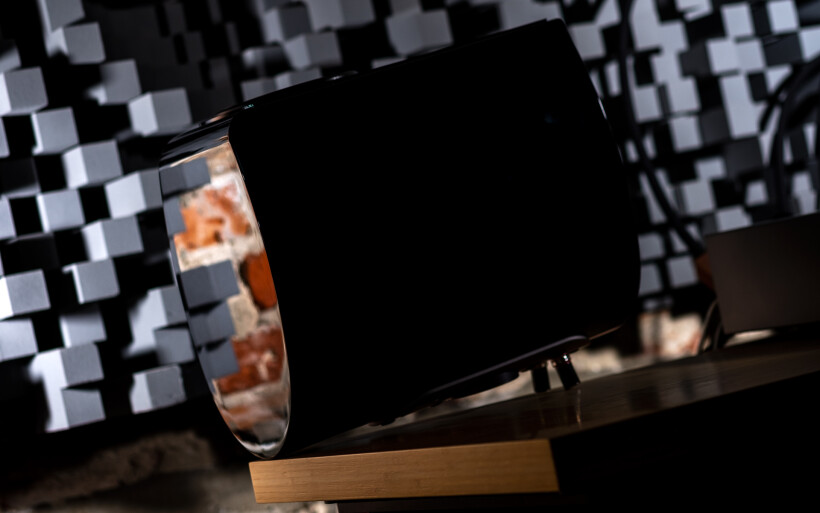 Camerton Binom-1 is a stand-mount rear-ported monitor that incorporates just a single full-range driver per channel. Each speaker measures enjoyably civilized 200 x 285 x 300mm (H x W x D) and weighs 8kg, so one person can easily manage it. Published specs list nominal impedance of 8Ω, 32Hz-28kHz frequency response and unusually low for the breed sensitivity of 88dB (2.83V/1m). Maximum power is 100W and recommended power amp output spans quite the gamut of 15-150W. Available finishes are either piano-gloss black or white. The former sent my way naturally turned this report’s photo work into a small nightmare. Still, such challenges are necessity if one wants to learn how to get better at it and develop extra skills along the way.
Camerton Binom-1 is a stand-mount rear-ported monitor that incorporates just a single full-range driver per channel. Each speaker measures enjoyably civilized 200 x 285 x 300mm (H x W x D) and weighs 8kg, so one person can easily manage it. Published specs list nominal impedance of 8Ω, 32Hz-28kHz frequency response and unusually low for the breed sensitivity of 88dB (2.83V/1m). Maximum power is 100W and recommended power amp output spans quite the gamut of 15-150W. Available finishes are either piano-gloss black or white. The former sent my way naturally turned this report’s photo work into a small nightmare. Still, such challenges are necessity if one wants to learn how to get better at it and develop extra skills along the way. Camerton Binom-1’s Plywood cabinets feature regular proportions, 2mm-thick glossy lacquer coating and multiple curvatures for appealing very clean dress code. Each enclosure’s both cheeks and rear connect into one oval surface achieved from a single heavily bent wooden piece, whilst its top gently slopes down to seamlessly transition into the front baffle. This space incorporates a thick acrylic panel with the shiny silver Camerton logo inlaid near its lower ledge and the manufacturer’s latest Binom-A1 Rev.2 driver just above. I haven’t seen a paint job any better than the Binom-1’s black shiny skins deep enough to literally drown in them. Voxativ Zeth put together at the Schimmel Pianos is the only one I’d rate similarly high on this count. Today’s business end features a large 4mm-thick aluminium piece bent to finely match its rounded sculpture. Four hex bolt heads on this element separate a nameplate, aluminium bass-reflex port and single-wire speaker terminals dressed in carbon.
Camerton Binom-1’s Plywood cabinets feature regular proportions, 2mm-thick glossy lacquer coating and multiple curvatures for appealing very clean dress code. Each enclosure’s both cheeks and rear connect into one oval surface achieved from a single heavily bent wooden piece, whilst its top gently slopes down to seamlessly transition into the front baffle. This space incorporates a thick acrylic panel with the shiny silver Camerton logo inlaid near its lower ledge and the manufacturer’s latest Binom-A1 Rev.2 driver just above. I haven’t seen a paint job any better than the Binom-1’s black shiny skins deep enough to literally drown in them. Voxativ Zeth put together at the Schimmel Pianos is the only one I’d rate similarly high on this count. Today’s business end features a large 4mm-thick aluminium piece bent to finely match its rounded sculpture. Four hex bolt heads on this element separate a nameplate, aluminium bass-reflex port and single-wire speaker terminals dressed in carbon.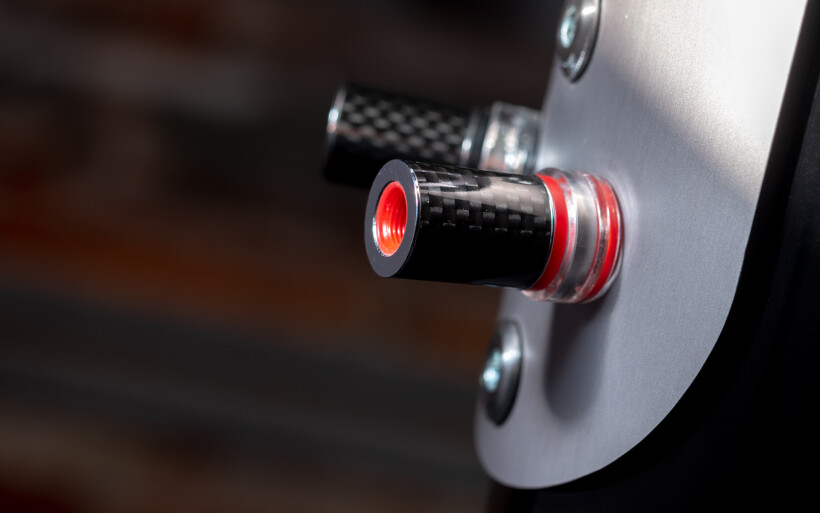 The Binom-1’s luxurious exterior, involved materials and complicated ambitious form factor already tell us that a lot of effort was put into this project and it had to be costly to manufacture. That’s about enough to have most shoppers after premium audio hardware for their living rooms properly interested, but this report’s product isn’t just a fancy expensive box targeted mainly at such clientele. Quite the contrary, this gorgeous looker promises us sonics it honestly shouldn’t do. A small full-range monitor product that works without any support might not sound like much to individuals not familiar with the breed, but those who are should already understand that it’s either a big chassis, or more than one driver. Not today, I can tell you as early as now that Oleh truly managed to reach that impossible summit. It turns out that a metric ton of engineering and his radically different take on the widebander kind got him there.
The Binom-1’s luxurious exterior, involved materials and complicated ambitious form factor already tell us that a lot of effort was put into this project and it had to be costly to manufacture. That’s about enough to have most shoppers after premium audio hardware for their living rooms properly interested, but this report’s product isn’t just a fancy expensive box targeted mainly at such clientele. Quite the contrary, this gorgeous looker promises us sonics it honestly shouldn’t do. A small full-range monitor product that works without any support might not sound like much to individuals not familiar with the breed, but those who are should already understand that it’s either a big chassis, or more than one driver. Not today, I can tell you as early as now that Oleh truly managed to reach that impossible summit. It turns out that a metric ton of engineering and his radically different take on the widebander kind got him there.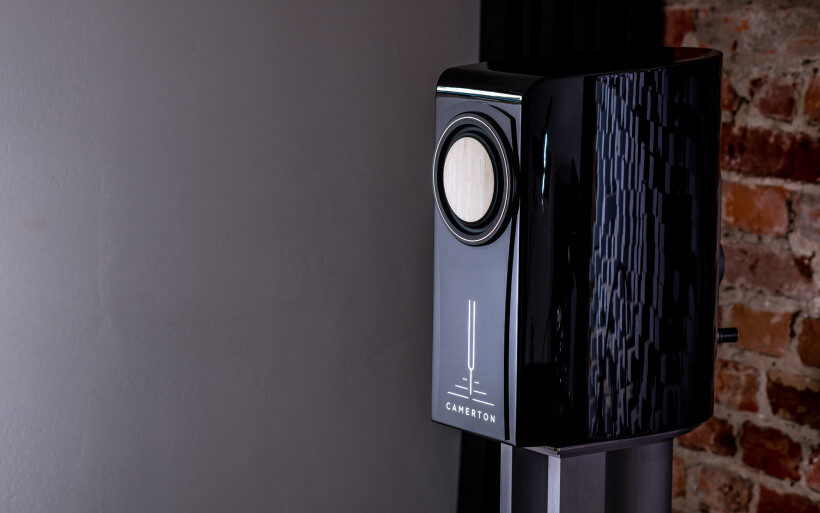 The Binom-1’s each vented Plywood enclosure houses just one full-range driver directly connected to speaker terminals and that’s it. It features no crossovers, damping materials and elaborate internal escape plots so might mistakenly be taken as very simple to make, but the difficulty was in making this simplicity effective. The Ukrainian’s holistic approach resulted in a very efficacious system with very well-developed bass from roughly 10-15 times lesser internal volume than normally, and his enclosures are deliberately compact for their high natural resonant frequencies. To raise them even higher, an internal steel brace’s one end locks the driver into position, whereas the other firmly torqued to a rear aluminium plate puts the entire structure under constant tension sealed from the outside by a thick lacquer coat. It’s interesting that Camerton’s paint job looks great and serves this mechanical purpose. Listed measures effectively push naturally occurring resonant frequencies within a cabinet to a bandwidth where it easily damps their parasitic resonances on its own, and here Camerton’s material selection and geometry contribute. A very silent box without any fillers or extra reinforcing components inside is the result. Its rear port tuned 10Hz below the driver’s own resonances breaks them to reduce opposing current and effectively increase bass output.
The Binom-1’s each vented Plywood enclosure houses just one full-range driver directly connected to speaker terminals and that’s it. It features no crossovers, damping materials and elaborate internal escape plots so might mistakenly be taken as very simple to make, but the difficulty was in making this simplicity effective. The Ukrainian’s holistic approach resulted in a very efficacious system with very well-developed bass from roughly 10-15 times lesser internal volume than normally, and his enclosures are deliberately compact for their high natural resonant frequencies. To raise them even higher, an internal steel brace’s one end locks the driver into position, whereas the other firmly torqued to a rear aluminium plate puts the entire structure under constant tension sealed from the outside by a thick lacquer coat. It’s interesting that Camerton’s paint job looks great and serves this mechanical purpose. Listed measures effectively push naturally occurring resonant frequencies within a cabinet to a bandwidth where it easily damps their parasitic resonances on its own, and here Camerton’s material selection and geometry contribute. A very silent box without any fillers or extra reinforcing components inside is the result. Its rear port tuned 10Hz below the driver’s own resonances breaks them to reduce opposing current and effectively increase bass output.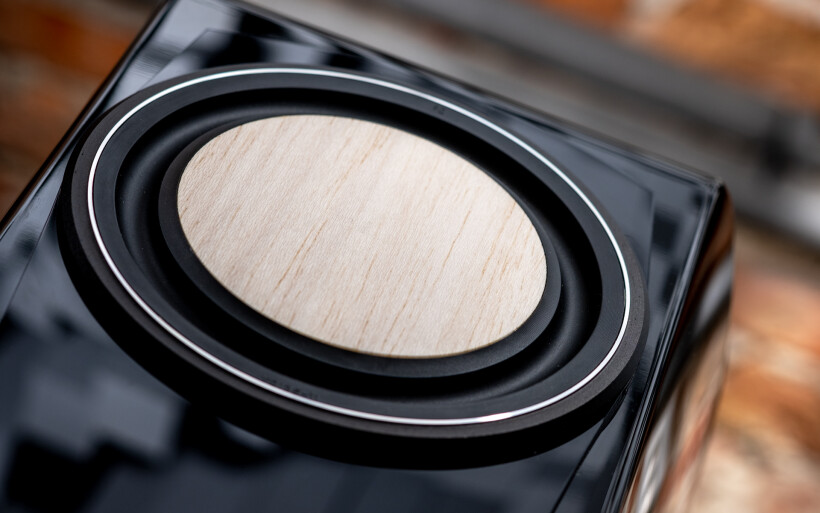 Camerton Binom-1’s transducer was designed to cover the entire bandwidth and work best without any other drivers nearby. Since there aren’t any, its flat diaphragm as the only moving element propagates all waves without any intersections or reflections. Its inverted surround and trimmed edges also prevent any such interactions, whilst positioning just a hair above baskets negates undesirable mini-horn loading effects. This cone shows balsa wood on the outside, but is in fact a composite that also includes a rear insert made of isotropic carbon fiber impregnated with a special high-damping compound. Its job is to remove all unwanted resonances and prevent secondary electric currents in it, so that strong magnetic fields don’t distort the membrane during movement. Oleh’s selection of materials and geometry resulted in a diaphragm free from any break-up regions that divides the entire bandwidth into three modal zones. Up to 2’000Hz it moves like a piston all across its surface, and from this point to 8’000Hz is a bending-wave emitter that reaches its maximum movement in the middle. The driver’s inner elastic traversal cone connected to the voice-coil former supports the entire cone, but within the 8’000-28’000Hz range also makes only its center active. A thin external wooden layer smooths out the entire frequency response.
Camerton Binom-1’s transducer was designed to cover the entire bandwidth and work best without any other drivers nearby. Since there aren’t any, its flat diaphragm as the only moving element propagates all waves without any intersections or reflections. Its inverted surround and trimmed edges also prevent any such interactions, whilst positioning just a hair above baskets negates undesirable mini-horn loading effects. This cone shows balsa wood on the outside, but is in fact a composite that also includes a rear insert made of isotropic carbon fiber impregnated with a special high-damping compound. Its job is to remove all unwanted resonances and prevent secondary electric currents in it, so that strong magnetic fields don’t distort the membrane during movement. Oleh’s selection of materials and geometry resulted in a diaphragm free from any break-up regions that divides the entire bandwidth into three modal zones. Up to 2’000Hz it moves like a piston all across its surface, and from this point to 8’000Hz is a bending-wave emitter that reaches its maximum movement in the middle. The driver’s inner elastic traversal cone connected to the voice-coil former supports the entire cone, but within the 8’000-28’000Hz range also makes only its center active. A thin external wooden layer smooths out the entire frequency response. The driver’s CNC-milled aluminium alloy basket features a half-closed motor based on two identical neodymium magnets. A large U-shaped magnetic element, its core and upper flange create a geometric structure that forms a symmetrical magnetic field for the voice coil, so that it can move linearly regardless of its position. To prevent inducing a secondary current on it that would result in distortion, the core and its neighboring pole plate comprise of multiple glued panels made of a special anisotropic alloy that increases their electrical resistance in the axial plane, and also helps to correctly form the magnetic field itself. The entire motor is additionally tightened via bolts. For more specific info I encourage you to take a look at Srajan’s story, where Oleh’s unique MO was explained in greater detail.
The driver’s CNC-milled aluminium alloy basket features a half-closed motor based on two identical neodymium magnets. A large U-shaped magnetic element, its core and upper flange create a geometric structure that forms a symmetrical magnetic field for the voice coil, so that it can move linearly regardless of its position. To prevent inducing a secondary current on it that would result in distortion, the core and its neighboring pole plate comprise of multiple glued panels made of a special anisotropic alloy that increases their electrical resistance in the axial plane, and also helps to correctly form the magnetic field itself. The entire motor is additionally tightened via bolts. For more specific info I encourage you to take a look at Srajan’s story, where Oleh’s unique MO was explained in greater detail.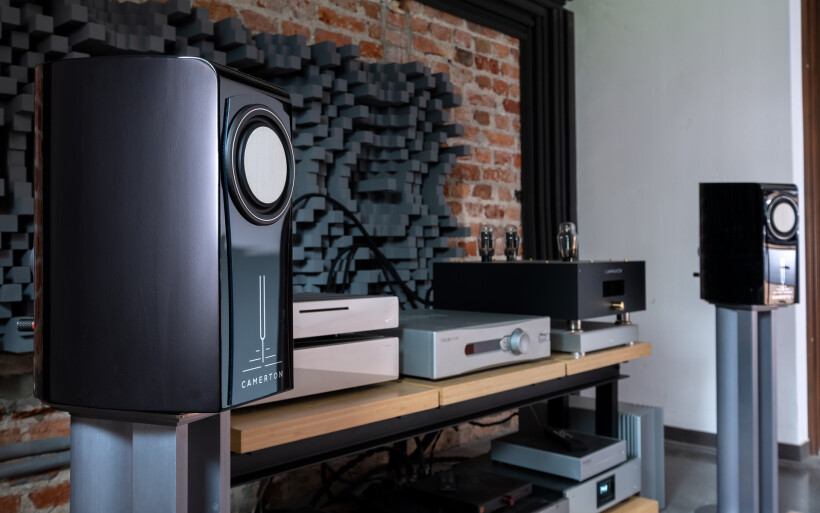 The Camerton site tells us that its founder charges accordingly for his amassed know-how. Binom-A/A1/A1 Rev.2 transducers for one’s own DIY project respectively sell for €4’900/5’900/7’800/pr. The most affordable Binom-1.0 speaker set is €9’745/pr. The Binom-1.1 loaner pair reviewed at 6moons.com had €11’900/pr on its sticker. This report’s top shelf Binom-1.2 version demands a cool €18’900/pr, and upon adding its fantastic stands the total bill shows €23’300. That’s twice as much as the sound|kaos Vox 3afw, still more than my Boenicke W11 SE+, and roughly where Børresen’s 01 monitors start. Camerton’s dearest specimen is thus an extreme proposition for wealthy consumers, and now it’s time to find out how it performs.
The Camerton site tells us that its founder charges accordingly for his amassed know-how. Binom-A/A1/A1 Rev.2 transducers for one’s own DIY project respectively sell for €4’900/5’900/7’800/pr. The most affordable Binom-1.0 speaker set is €9’745/pr. The Binom-1.1 loaner pair reviewed at 6moons.com had €11’900/pr on its sticker. This report’s top shelf Binom-1.2 version demands a cool €18’900/pr, and upon adding its fantastic stands the total bill shows €23’300. That’s twice as much as the sound|kaos Vox 3afw, still more than my Boenicke W11 SE+, and roughly where Børresen’s 01 monitors start. Camerton’s dearest specimen is thus an extreme proposition for wealthy consumers, and now it’s time to find out how it performs.
Sound
The Innuos Statement handled storage/transport, then a LampizatOr Pacific DAC (KR Audio T-100/Living Voice 300B + KR Audio 5U4G Ltd. Ed.) passed signal to either a Trilogy 915R/995R set or Bakoon AMP-13R that connected via a Boenicke Audio S3 speaker cable to Camerton’s speaker set, and sound|kaos Vox 3afw monitors were its main opponent. Interconnects used were Boenicke Audio IC3 CG and XLRs which I DIY-ed. All key hardware was powered by Boenicke Audio Power Gate distributor box plus its three captive M2 cords and two LessLoss C-MARCs. The USB chain included only one Mercury3.0 USB cable. A set of external LessLoss Firewall for Loudspeakers modules complimented both speaker sets, while a Fidelizer EtherStream was in-between my Linksys WRT160N router and Innuos Statement server. A GigaWatt PC-3 SE EVO+ power conditioner fronted by its own LC-3 EVO cable fed ISOL-8’s Prometheus PSU connected to the router and network switch.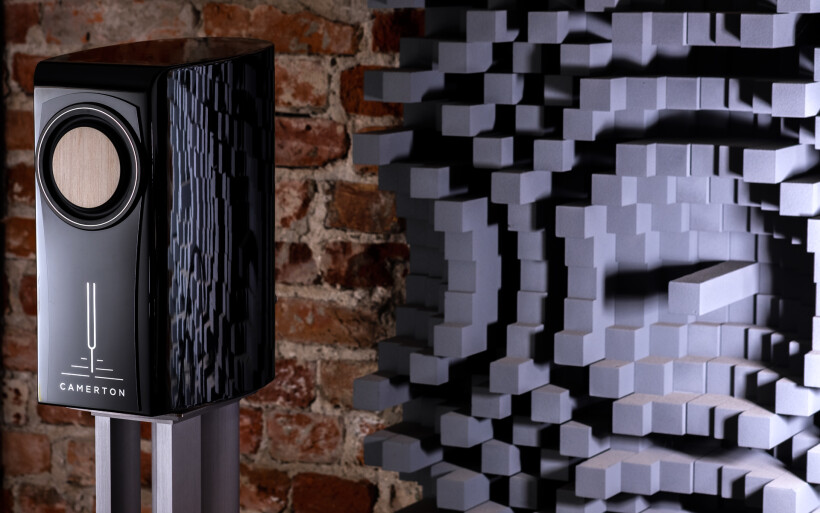 As per usual with new speaker arrivals, the Binom-1’s optimal positioning was the top priority. Oleh’s own stands are rather tall, so any extreme nearfield scenarios highly useful for the far shorter sound|kaos Vox 3afw were off the table. Still, today’s marvel was more than happy some 100/55cm away respectively from my room’s front/rear walls, so roughly where regular two-ways would usually stand. Its ports closer to a brick surface in there netted extra bass boost, and slimmer more outlined performance was available upon increasing that distance. Such responsiveness to these triangulations isn’t anything unordinary for vented products, but the Binom-1’s greater sensible acceleration upon coupling its bores tighter with my crib’s front wall was new. Normally it’s the other way around. Moving on, just a gentle toe in was all it took for this product to render all virtual shapes pleasantly firm and nicely locked into place. Its generous off-axis response was a highly unusual trait given full-range speakers’ beaming directivity.
As per usual with new speaker arrivals, the Binom-1’s optimal positioning was the top priority. Oleh’s own stands are rather tall, so any extreme nearfield scenarios highly useful for the far shorter sound|kaos Vox 3afw were off the table. Still, today’s marvel was more than happy some 100/55cm away respectively from my room’s front/rear walls, so roughly where regular two-ways would usually stand. Its ports closer to a brick surface in there netted extra bass boost, and slimmer more outlined performance was available upon increasing that distance. Such responsiveness to these triangulations isn’t anything unordinary for vented products, but the Binom-1’s greater sensible acceleration upon coupling its bores tighter with my crib’s front wall was new. Normally it’s the other way around. Moving on, just a gentle toe in was all it took for this product to render all virtual shapes pleasantly firm and nicely locked into place. Its generous off-axis response was a highly unusual trait given full-range speakers’ beaming directivity.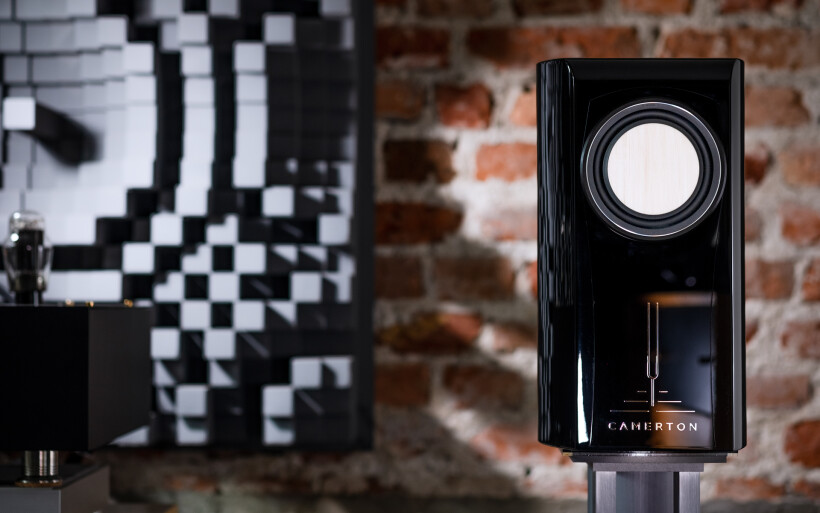 Here’s where I normally tackle hardware fit for a given speaker job, but this time around there’s not much to write about. The Binom-1 didn’t need a unicorn amp to get going and was very clear about that, but it also quickly informed me about its appetite for power. The more was provided, the more stout and slamming its behavior was, to a point where it became quite silly. At first I wasn’t quite sure what to make of this. Full-range transducers don’t scale like so. If pushed too hard, these inherently delicate creatures shout and one’s ears know well when that happens. In this context the Binom-1 was made of steel and quite frankly unbreakable. It poked fun at its own kind’s fragility and most certainly didn’t know how to scream. Cube Audio’s Nenuphar was also very resilient on this front, but not this much.
Here’s where I normally tackle hardware fit for a given speaker job, but this time around there’s not much to write about. The Binom-1 didn’t need a unicorn amp to get going and was very clear about that, but it also quickly informed me about its appetite for power. The more was provided, the more stout and slamming its behavior was, to a point where it became quite silly. At first I wasn’t quite sure what to make of this. Full-range transducers don’t scale like so. If pushed too hard, these inherently delicate creatures shout and one’s ears know well when that happens. In this context the Binom-1 was made of steel and quite frankly unbreakable. It poked fun at its own kind’s fragility and most certainly didn’t know how to scream. Cube Audio’s Nenuphar was also very resilient on this front, but not this much. The Binom-1’s wicked bass response and immunity to claptrap were no lucky accidents. Its ports very cleanly and effortlessly decompressed into my room even at stupid loud volume levels. No common symptoms past getting there – here I mean sound thin, brittle, piercing, shaky or smeared – meant that Oleh’s well-engineered vaccine against the boomy shouty virus worked like a charm. On these fronts his loaner truly was insane, it just kept on developing muscle tissue and sensible reach along with SPL increase until my ears eventually had to capitulate. I’m quite confident that the Binom-1 would take all the juice the two 995R monos had to spare without a flinch, but -25dB on Trilogy 915R’s display was plenty already. The Bakoon had to show full four upper LEDs out of five available to reach roughly the same volume level.
The Binom-1’s wicked bass response and immunity to claptrap were no lucky accidents. Its ports very cleanly and effortlessly decompressed into my room even at stupid loud volume levels. No common symptoms past getting there – here I mean sound thin, brittle, piercing, shaky or smeared – meant that Oleh’s well-engineered vaccine against the boomy shouty virus worked like a charm. On these fronts his loaner truly was insane, it just kept on developing muscle tissue and sensible reach along with SPL increase until my ears eventually had to capitulate. I’m quite confident that the Binom-1 would take all the juice the two 995R monos had to spare without a flinch, but -25dB on Trilogy 915R’s display was plenty already. The Bakoon had to show full four upper LEDs out of five available to reach roughly the same volume level.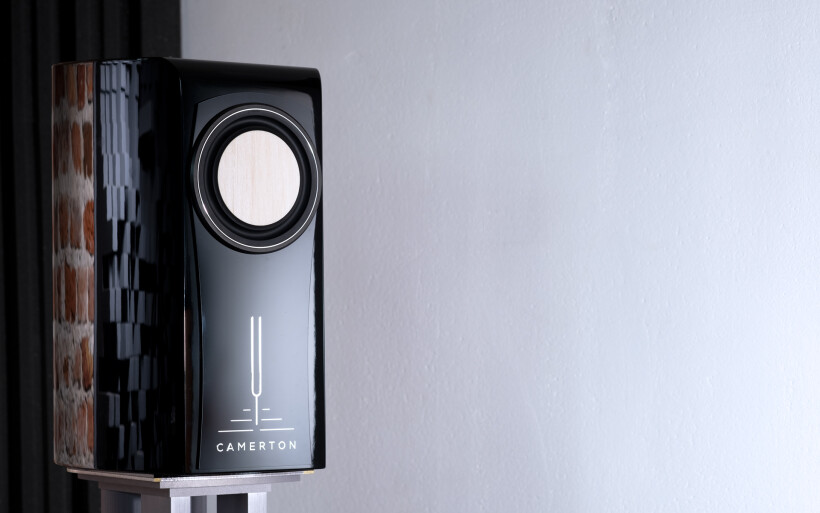 Just to move this matter out of the way, the AMP-13R projected finer more visibly pronounced outlines, was more articulate, had a tad weightier glossier HF and it in general made more sensual posher sound than the two 995R towers, but surprisingly also felt calmer and not as explosive as these hulks. Although the former amp was quite irreplaceable with i.e. acoustic jobs and calm vocal lines dosed at mild SPL, Trilogy’s reference set retaliated on overall ease and might with repertoire best served loud to reveal all the excitement embedded. In the past I’ve compared these products multiple times and I still consider the Bakoon as the more sophisticated and accomplished device. However, the Binom-1’s crave for power and its ability to potently scale with it simply labeled 995R monos as the better match for this load. The fact that it worked very well with two different transistor devices (…technically Trilogy’s amps are hybrids, but their output devices are solid state) is telling, and also quite the twist considering widebanders’ well-known fondness for tube company.
Just to move this matter out of the way, the AMP-13R projected finer more visibly pronounced outlines, was more articulate, had a tad weightier glossier HF and it in general made more sensual posher sound than the two 995R towers, but surprisingly also felt calmer and not as explosive as these hulks. Although the former amp was quite irreplaceable with i.e. acoustic jobs and calm vocal lines dosed at mild SPL, Trilogy’s reference set retaliated on overall ease and might with repertoire best served loud to reveal all the excitement embedded. In the past I’ve compared these products multiple times and I still consider the Bakoon as the more sophisticated and accomplished device. However, the Binom-1’s crave for power and its ability to potently scale with it simply labeled 995R monos as the better match for this load. The fact that it worked very well with two different transistor devices (…technically Trilogy’s amps are hybrids, but their output devices are solid state) is telling, and also quite the twist considering widebanders’ well-known fondness for tube company.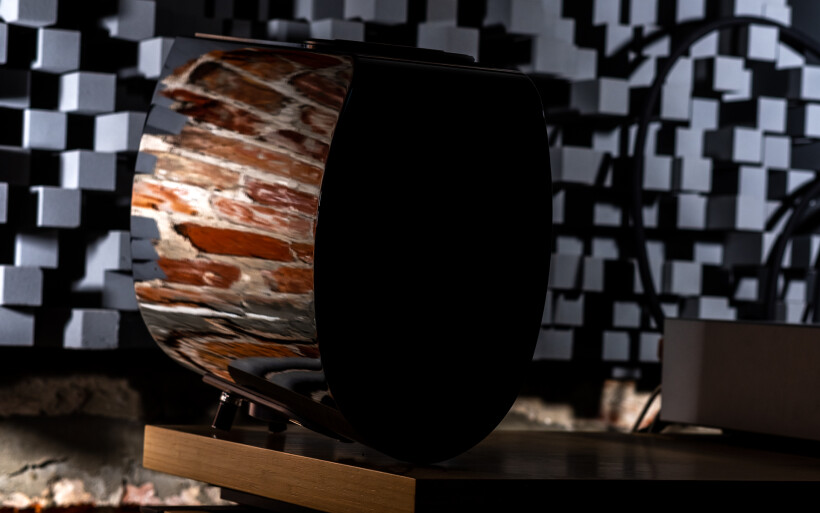 The more time I’d spent with the Binom-1, the more its voicing struck me as a hybrid of traits typical for regular full-range speaker sets and upper echelon two-ways. From the former kind it inherited amazing spatial accuracy, point source directivity, high oxygenation, freshness, quick reflexes, elasticity, layering complexity, immediacy and ability to intimately project virtual frames. Only broadband drivers pull vocal and instrumental jobs this exposed, fetching, expressive, present, charming, sensual and distinct. On these fronts the Binom-1 truly was a fully-fledged widebander type and I had no doubts about that. Still, the line between typically artful sexy full-range presentation and unpleasantly brittle piercing skinny sound is very thin, and Oleh’s product didn’t come any close to it. At least I wasn’t able to steer it there, which was remarkable given its type.
The more time I’d spent with the Binom-1, the more its voicing struck me as a hybrid of traits typical for regular full-range speaker sets and upper echelon two-ways. From the former kind it inherited amazing spatial accuracy, point source directivity, high oxygenation, freshness, quick reflexes, elasticity, layering complexity, immediacy and ability to intimately project virtual frames. Only broadband drivers pull vocal and instrumental jobs this exposed, fetching, expressive, present, charming, sensual and distinct. On these fronts the Binom-1 truly was a fully-fledged widebander type and I had no doubts about that. Still, the line between typically artful sexy full-range presentation and unpleasantly brittle piercing skinny sound is very thin, and Oleh’s product didn’t come any close to it. At least I wasn’t able to steer it there, which was remarkable given its type. Hefty bass, highly saturated color palette and generous tonal substance all across its audible FR effectively positioned the Binom-1 noticeably closer to vented two-ways than its own kind. This departure at first was just as puzzling as everything else this speaker set did. Cube Audio’s Nenuphar only partially featured such ballsy round thick flavor. Other full-range products I’m aware of didn’t pursue it, not even augmented models by Rethm and sound|kaos. I can’t say, perhaps some die-hard full-range fanatics would find the Binom-1’s profile blasphemous enough to rally under Oleh’s window with pitchforks and torches. Even if so, my gut instinct predicts individuals thoroughly impressed with his accomplishment far stronger in number. Upon asking why would a widebander enthusiast even consider going after today’s rebel, its unorthodox blend of sonic traits is the obvious attractor, but a purist filterless monitor design that executed such audible uniqueness even more so. The Binom-1 unlike anything else out there on the market is thus the reason.
Hefty bass, highly saturated color palette and generous tonal substance all across its audible FR effectively positioned the Binom-1 noticeably closer to vented two-ways than its own kind. This departure at first was just as puzzling as everything else this speaker set did. Cube Audio’s Nenuphar only partially featured such ballsy round thick flavor. Other full-range products I’m aware of didn’t pursue it, not even augmented models by Rethm and sound|kaos. I can’t say, perhaps some die-hard full-range fanatics would find the Binom-1’s profile blasphemous enough to rally under Oleh’s window with pitchforks and torches. Even if so, my gut instinct predicts individuals thoroughly impressed with his accomplishment far stronger in number. Upon asking why would a widebander enthusiast even consider going after today’s rebel, its unorthodox blend of sonic traits is the obvious attractor, but a purist filterless monitor design that executed such audible uniqueness even more so. The Binom-1 unlike anything else out there on the market is thus the reason.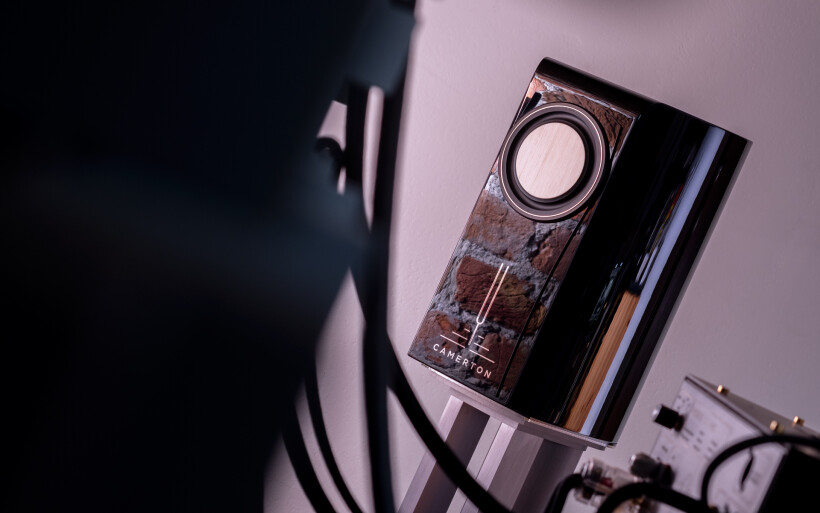 High score on tonal mass and overall substance goes hand in hand with softer outlines and round general behavior, but it’s also fair to expect lower notes on i.e. resolution, quickness, energy and tactility. Although the Binom-1 had its own biases just as every other speaker set, hearing its widebander directness, accuracy and spatial specificity merged with pleasant thickness without any signs of hollowness, shout and wobble surely was a treat. Even if so geared regular speakers exist, Oleh’s product clearly has them beat on design elegance and simplicity. It’s just one driver per box after all.
High score on tonal mass and overall substance goes hand in hand with softer outlines and round general behavior, but it’s also fair to expect lower notes on i.e. resolution, quickness, energy and tactility. Although the Binom-1 had its own biases just as every other speaker set, hearing its widebander directness, accuracy and spatial specificity merged with pleasant thickness without any signs of hollowness, shout and wobble surely was a treat. Even if so geared regular speakers exist, Oleh’s product clearly has them beat on design elegance and simplicity. It’s just one driver per box after all.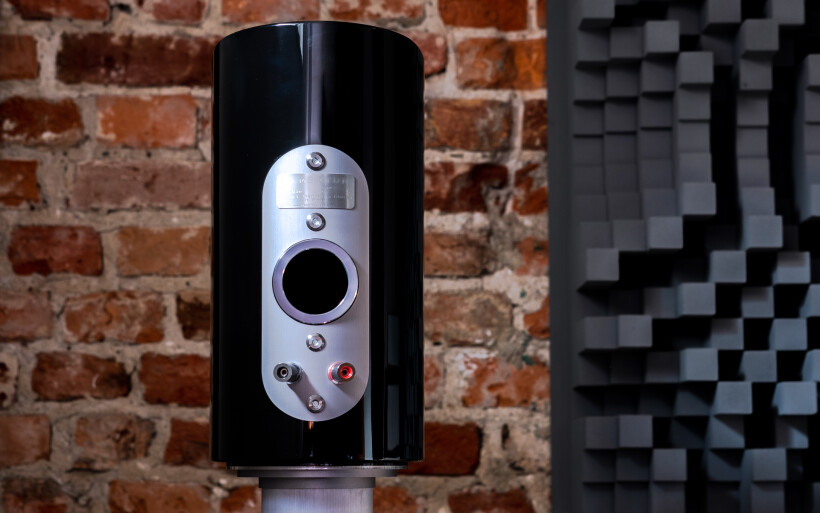 Next the Binom-1 had to go against a proper sparring partner in form of the sound|kaos Vox 3afw loaner still at my place. Let me stress again that the latter is a three-way design with a far larger membrane surface to boot. Each its petite wooden chassis houses one full-range transducer, two side-firing force-cancelling 5″ woofers and Raal’s upfiring ambient ribbon tweeter. Upon cranking the 915R’s volume the more sensitive Swiss picked up more background noise whilst Oleh’s product gave just a mild hum, which wasn’t surprising at all. Both contestants’ high score on immediacy, clarity, sensual vocals and the lot was also a given considering their type, but other than this they weren’t alike at all.
Next the Binom-1 had to go against a proper sparring partner in form of the sound|kaos Vox 3afw loaner still at my place. Let me stress again that the latter is a three-way design with a far larger membrane surface to boot. Each its petite wooden chassis houses one full-range transducer, two side-firing force-cancelling 5″ woofers and Raal’s upfiring ambient ribbon tweeter. Upon cranking the 915R’s volume the more sensitive Swiss picked up more background noise whilst Oleh’s product gave just a mild hum, which wasn’t surprising at all. Both contestants’ high score on immediacy, clarity, sensual vocals and the lot was also a given considering their type, but other than this they weren’t alike at all.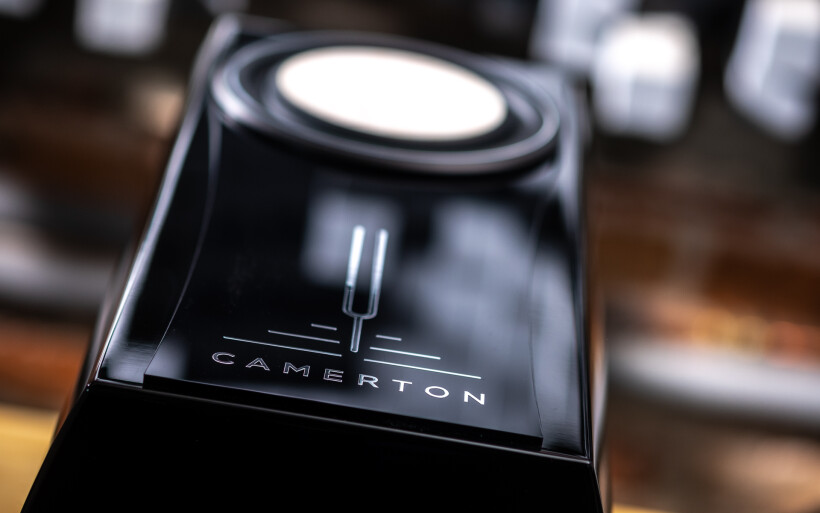 The result of the Binom-1’s fight with the sound|kaos was easy to predict. Their in-built full-range aroma aside, the former’s most prominent features in form of textural richness, elevated color temperature and well-developed fatty tissue were served at a cost of lesser grip and traction. A beefy round profile perceived as more relaxed, slower and substantially heavier versus a slimmer more agile approach is the natural order of things, all this can’t be possibly had at once. In this context the Vox 3afw nowhere near as meaty as the Binom-1 was more nimble and visceral, whereas its greater cone surface secured lower sensible reach and more firm, tighter and energized general feel. The Camerton felt milder, gutsier and more earthy.
The result of the Binom-1’s fight with the sound|kaos was easy to predict. Their in-built full-range aroma aside, the former’s most prominent features in form of textural richness, elevated color temperature and well-developed fatty tissue were served at a cost of lesser grip and traction. A beefy round profile perceived as more relaxed, slower and substantially heavier versus a slimmer more agile approach is the natural order of things, all this can’t be possibly had at once. In this context the Vox 3afw nowhere near as meaty as the Binom-1 was more nimble and visceral, whereas its greater cone surface secured lower sensible reach and more firm, tighter and energized general feel. The Camerton felt milder, gutsier and more earthy.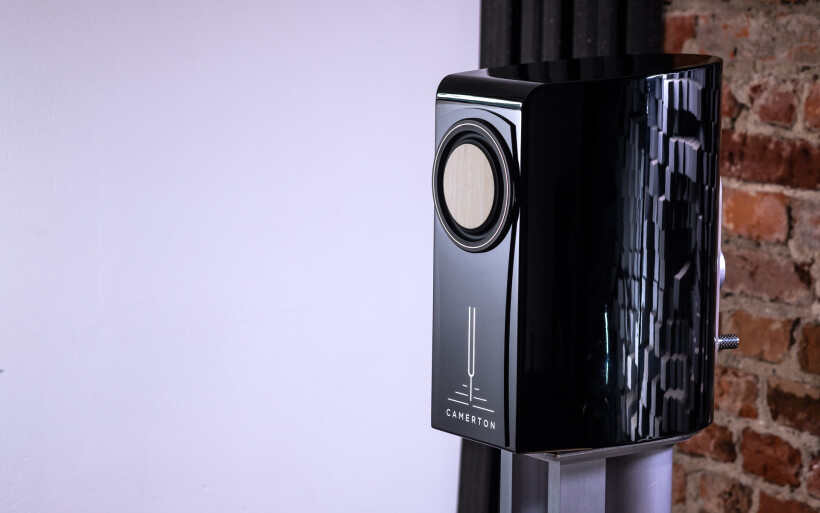 The Binom-1’s detour towards the more liberal fat provision resulted in audible thickness extended all the way up, but without the usual culprits of such tuning; boom, poor definition, decreased articulation and weakened attack. The Vox 3afw’s emphasis on lowest audible octaves and rather economic filler dosage in the upper bass contributed to its quick ripped voicing, increased clarity above this range and also unwanted smear kept at bay. In effect the Camerton was a touch darker and less glossy in comparison to the Swiss’ quicker harder jabs and finer posher brilliance region. But more importantly, the general gestalt shift past going from one speaker set to another was very clear. These significant mood swings had a major impact on how I perceived both compared products.
The Binom-1’s detour towards the more liberal fat provision resulted in audible thickness extended all the way up, but without the usual culprits of such tuning; boom, poor definition, decreased articulation and weakened attack. The Vox 3afw’s emphasis on lowest audible octaves and rather economic filler dosage in the upper bass contributed to its quick ripped voicing, increased clarity above this range and also unwanted smear kept at bay. In effect the Camerton was a touch darker and less glossy in comparison to the Swiss’ quicker harder jabs and finer posher brilliance region. But more importantly, the general gestalt shift past going from one speaker set to another was very clear. These significant mood swings had a major impact on how I perceived both compared products.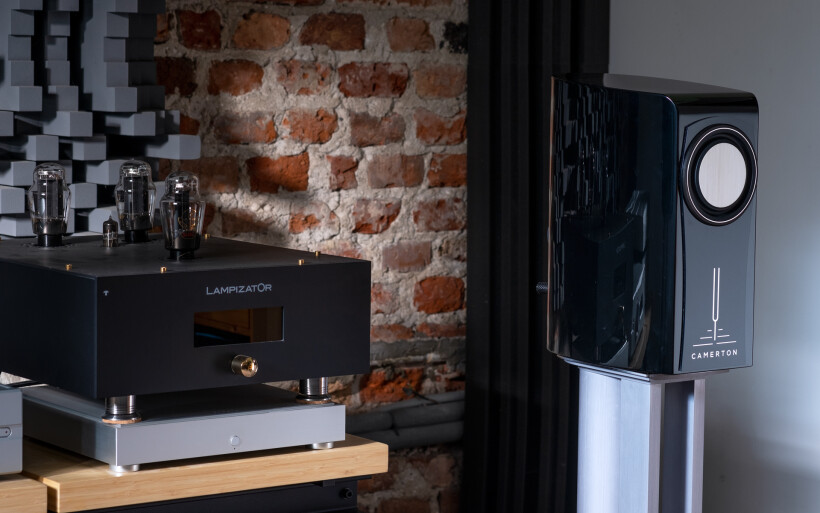 At its core the Binom-1’s profile felt more like a solid well-grounded two-way infused with qualities directly related to its purist broadband topology. In this sense the Vox 3afw geared for hard hits, propulsion, clarity, ease, illumination and spicier more shimmery sonic vibe had its full-range flavor pronounced more. Their spatial action confirmed these findings. The Camerton drew thicker optically bolder virtual frames more closely one to another and with less oxygen in-between than the sound|kaos, which projected more clear images with somewhat cooler sound sources outlined via sharper pencil swings. Today’s speaker set was texturally loaded to focus my attention on color intensity, natural softness and moody atmosphere, which rendered the Vox 3afw as stiffer, more elastic, direct and articulate, and in a way somewhat mechanical. The Swiss’ potent headphone-like aural bubbles had me on stage surrounded by musicians, whereas the Binom-1 secured a place for me in the first row, could easily go louder and – due to its more gravitational rounder disposition – wasn’t as fussy about music quality.
At its core the Binom-1’s profile felt more like a solid well-grounded two-way infused with qualities directly related to its purist broadband topology. In this sense the Vox 3afw geared for hard hits, propulsion, clarity, ease, illumination and spicier more shimmery sonic vibe had its full-range flavor pronounced more. Their spatial action confirmed these findings. The Camerton drew thicker optically bolder virtual frames more closely one to another and with less oxygen in-between than the sound|kaos, which projected more clear images with somewhat cooler sound sources outlined via sharper pencil swings. Today’s speaker set was texturally loaded to focus my attention on color intensity, natural softness and moody atmosphere, which rendered the Vox 3afw as stiffer, more elastic, direct and articulate, and in a way somewhat mechanical. The Swiss’ potent headphone-like aural bubbles had me on stage surrounded by musicians, whereas the Binom-1 secured a place for me in the first row, could easily go louder and – due to its more gravitational rounder disposition – wasn’t as fussy about music quality.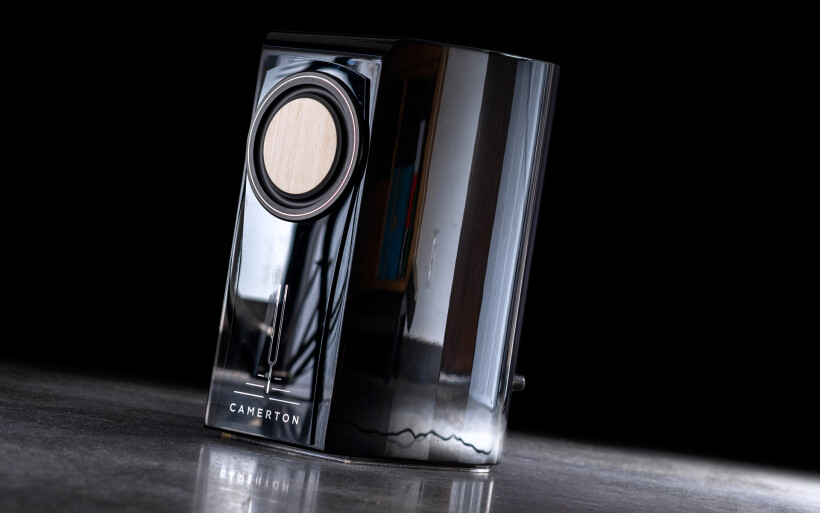 The Vox 3afw’s upper hand on technical aspects such as speed, resolution and sensibly more pronounced both FR ends wasn’t a surprise. Its Enviée drivers didn’t do everything on their own and assistance they had was top notch. However, what the Binom-1’s each transducer inside its own enclosure delivered without any help at all was no less than spectacular. That’s key. In the grand scheme Oleh’s product neither fell short on bandwidth, nor quickness, imaging, elasticity, insight or precision, but scored unreasonably high on saturation, fullness, textures and ability to effortlessly work solo without any hesitation. No other similar speaker set among those I know covers all these bases. That’s why the Camerton’s minimalist arsenal I see as fit for wars against any other monitor product I can think of, and the odds of it being clearly dwarfed in any such a comparison are very unrealistic if not impossible.
The Vox 3afw’s upper hand on technical aspects such as speed, resolution and sensibly more pronounced both FR ends wasn’t a surprise. Its Enviée drivers didn’t do everything on their own and assistance they had was top notch. However, what the Binom-1’s each transducer inside its own enclosure delivered without any help at all was no less than spectacular. That’s key. In the grand scheme Oleh’s product neither fell short on bandwidth, nor quickness, imaging, elasticity, insight or precision, but scored unreasonably high on saturation, fullness, textures and ability to effortlessly work solo without any hesitation. No other similar speaker set among those I know covers all these bases. That’s why the Camerton’s minimalist arsenal I see as fit for wars against any other monitor product I can think of, and the odds of it being clearly dwarfed in any such a comparison are very unrealistic if not impossible. Although past the fight with the sound|kaos I had all the intel about the Camerton to finish this story, at least for a short while it had to go against the W11 SE+. My daily driver came first on bass crack and canvas size, but at a cost of being a bit behind both monitor models on imaging depth, specificity and directness. The big Swiss prioritized impact, power and quickness more than roundness and gravity, so was more similar to the sound|kaos than Camerton. To an extent the Boenicke was a grander Vox 3afw, but stripped from all its unmistakable widebander virtues which the Binom-1 also featured. This was a reminder that no speaker set in this review could possibly do everything the best. The two monitors’ elegant full-range traits were beyond reach of my reference that staged the largest. The sound|kaos was the most expressive and pronounced but couldn’t go loud as boldly and effortlessly as the other two. The Camerton had heft, romanticism and well-saturated colors its sportier stiffer rivals didn’t have, but they had their revenge on openness, air amount, snap and brilliance extension. The W11 SE+ was very picky about in-room positioning and the most problematic. The Vox 3afw favored one specific nearfield location substantially more but worked well everywhere. The Binom couldn’t care less. It’s time to wrap.
Although past the fight with the sound|kaos I had all the intel about the Camerton to finish this story, at least for a short while it had to go against the W11 SE+. My daily driver came first on bass crack and canvas size, but at a cost of being a bit behind both monitor models on imaging depth, specificity and directness. The big Swiss prioritized impact, power and quickness more than roundness and gravity, so was more similar to the sound|kaos than Camerton. To an extent the Boenicke was a grander Vox 3afw, but stripped from all its unmistakable widebander virtues which the Binom-1 also featured. This was a reminder that no speaker set in this review could possibly do everything the best. The two monitors’ elegant full-range traits were beyond reach of my reference that staged the largest. The sound|kaos was the most expressive and pronounced but couldn’t go loud as boldly and effortlessly as the other two. The Camerton had heft, romanticism and well-saturated colors its sportier stiffer rivals didn’t have, but they had their revenge on openness, air amount, snap and brilliance extension. The W11 SE+ was very picky about in-room positioning and the most problematic. The Vox 3afw favored one specific nearfield location substantially more but worked well everywhere. The Binom couldn’t care less. It’s time to wrap.
Summary
At first glance Camerton Binom-1’s compact frame and just few components might look like a staggering expense quite impossible to justify, but this sensation quickly fades upon experiencing what it does and how. Its minimalist means not only unlock disproportionately high sonic might that will leave most full-range fans shocked, but they also spell out a major achievement unlike any other speaker set out there as far as I’m aware. It resets the widebander game in a truly marvelous fashion to prove us that what previously wasn’t possible now is, courtesy of Oleh Lizohoub.
Although Camerton Binom-1 is the first product released under the Ukrainian’s recently revived banner, the man clearly isn’t a newcomer. Today’s fit’n’finish implies no less than a perfectly executed sharply dressed luxurious affair that also scores silly high on overall domestication and in-room compliance. It doesn’t take much space, isn’t tricky to set up, works very well without a specialist amp, and radiates broadly enough to easily please more than one person at the same time. On these fronts Camerton Binom-1 is in fact far friendlier than what its purist topology might possibly suggest, enjoyably casual even. I had a fair share of regular speaker sets that caused far more trouble than this one.
Those quick to judge Camerton Binom-1 by sheer cost of two its sophisticated ingredients should know that’s all it needs to break rules, stomp on so stereotypes and stand defiant against its own kind so boldly that it’s funny. Although it represents ultimate simplicity targeted at well-seasoned connoisseurs willing to pursue a costly purist single-driver compact affair because it is just that and nothing more, its ballsy voicing generously sprinkled with the usual widebander aroma they can’t possibly see coming. Prior to sampling this product nobody can, that’s how unusual I think it is. My tip of the hat to Oleh for his radically different design philosophy, engineering talent and outstanding results. ‘Til next time!
Associated Equipment:
- Amplifier: Trilogy 995R
- DAC: LampizatOr Pacific (KR Audio T-100 / Living Voice 300B + KR Audio 5U4G Ltd. Ed.)
- Speakers: Boenicke Audio W11 SE+, sound|kaos Vox 3afw
- Transport: Innuos Statement
- Preamplifier: Trilogy 915R
- Speaker cables: Boenicke Audio S3, LessLoss C-MARC
- Speaker signal conditioning: LessLoss Firewall for Loudspeakers
- Interconnects: Boenicke Audio IC3 CG
- Power components: Gigawatt PC-3 SE EVO+/LC-3 EVO, LessLoss C-MARC, Boenicke Audio Power Gate
- USB components: iFi audio iGalvanic3.0, iFi audio micro iUSB3.0, 3x iFi audio Mercury3.0, iPower 9V
- Rack: Franc Audio Accesories Wood Block Rack
- Network: Fidelizer EtherStream, Linksys WRT160N
- Music: NativeDSD
Retail prices of reviewed components in EU (incl. tax):
- Camerton Binom-1 (Binom-A1 Rev. 2 driver): €18’900/pr
- Camerton Binom stands: €4’400/pr
Manufacturer: Camerton Audio


